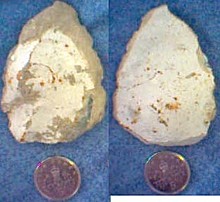|
|
|
|
The Coffin StoneNatural Rock Feature
|
|
|
|
Images (click to view fullsize) |
|
Photographs: Artistic / Interpretive:
Artistic / Interpretive:
|
Fieldnotes |
|
|
In a large field opposite Little Kit's Coty lies the natural outcrop of the Coffin Stone. We could see it clearly, but it was right in the middle of a crop of developing brassicas and we walked as far along the field edge as we could, but the light was fading fast and despite attempts I failed to get a decent photo of it. However, even from the distance from which we viewed it, it looked monumentally huge. This post appears as part of the weblog entry Clark's Kent
|
 Posted by Jane
Posted by Jane31st December 2003ce Edited 31st December 2003ce |
|
About 25 yards south of the Countless Stones is a turn off. I precariously parked here and crossed the road to an entrance to a bridleway to see if I could see the Coffin Stone in it's field. Luckily, the crop had been harvested, and the stone(s) stood proud of the field, in full sight. I didn't approach the stones on this ocassion, being contented enough just to see them, and not wanting to encroach on what is obviously a cropping field. A couple of hundred yards further south is an entrance to Great Tottington Farm. I may ask here next time for permission to actually visit the stones. There is also supposedly a circle, or ruined circle of stones (The Tottington Sarsens) at the head of the stream on the farm. It would be interesting to see if anything remains of this site/monument. This post appears as part of the weblog entry Medway & Bucks
|
14th September 2003ce Edited 14th September 2003ce |
Miscellaneous |
|
In the hedge on the left hand of the lane, and two hundred and seventy feet from the yard, lies the remarkable stone called by Dr. Stukeley, from its resemblance, the coffin stone, as only one side appears next the lane, the other parts being concealed by the mould, which in length of time has accumulated under the hedge, so that bushes and two elm-trees spread their roots on the surface of the stone.From John Thorpe's 'Custumale Roffense' (1788). *fleet = shallow |
 Posted by Rhiannon
Posted by Rhiannon5th September 2016ce Edited 5th September 2016ce |
|
‘View from afar’ 30.5.16 From the entrance to the ‘vineyard type’ place opposite the Countless Stones a large stone can be seen in the distance in the middle of a field. It is next to a tree, near the overhead power lines. This is a close as you are likely to get as the ‘vineyard’ has a double row of 6ft high fences ‘protecting’ the entrance. The vines (or whatever they are) have been planted all around it. Once they have grown taller it is likely that in the summer months the stone will not be visible from this spot. |
Posted by CARL 31st May 2016ce |
|
In the 1830s two skulls were found under the stone - so perhaps it is the remains of a tomb, and so part of the Medway group of Neolithic barrows where the Pilgrim's way crosses the river. Judging by the link below, it seems the farmer saw fit to pile another stone on top of it quite recently. The stone, called by Stukeley, "The Coffin," and now frequently and more appropriately "The Table Stone," lies close to Great Tottington Farm, in an open field on the opposite side of the lane to Lower Kit's Cotty. A hedge formerly concealed more than one-half of the stone, and in this condition it is depicted in Thorpe's Custumale Roffense, the east side alone being exposed. In 1836, this hedge was cleared away, so that the entire stone is now visible. From the same field in which the Coffin Stone lies, many stones have been removed, and others have been sunk in the ground in order to get them below the reach of the plough.On the megalithic remains in mid-Kent, by EHW Dunkin, in The Reliquary for Oct 1871. |
 Posted by Rhiannon
Posted by Rhiannon2nd May 2002ce Edited 31st May 2016ce |
Links |
|
Great Tottington's Sarsen StonesPaul Ashbee's article on the stones, especially with reference to the Coffin Stone. |
 Posted by Rhiannon
Posted by Rhiannon30th July 2003ce Edited 22nd October 2010ce |

